Intel NUC 13 Pro Arena Canyon Review: Raptor Lake Brings Incremental Gains
by Ganesh T S on March 27, 2023 9:00 AM ESTHTPC and Digital Signage Credentials
The 2022 Q4 update to our system reviews brings an updated media playback evaluation suite for systems. After doing away with the evaluation of display refresh rate stability and Netflix streaming evaluation, the local media playback configurations have also seen a revamp. This section details each of the workloads processed on the Intel NUC13ANKi7 (Arena Canyon).
YouTube Streaming Efficiency
YouTube continues to remain one of the top OTT platforms, primarily due to its free ad-supported tier. Our HTPC test suite update retains YouTube streaming efficiency evaluation as a metric of OTT support in different systems. Mystery Box's Peru 8K HDR 60FPS video is the chosen test sample. On PCs running Windows, it is recommended that HDR streaming videos be viewed using the Microsoft Edge browser after putting the desktop in HDR mode.
The GPU in Intel NUC13ANKi7 (Arena Canyon) supports hardware decoding of VP9 Profile 2, and we see the stream encoded with that codec being played back. The streaming is perfect, thanks to the powerful GPU and hardware decoding support - the dropped frames observed in the statistics below are due to mouse clicks involved in bringing up the overlay.
The streaming efficiency-related aspects such as GPU usage and at-wall power consumption are also graphed below.
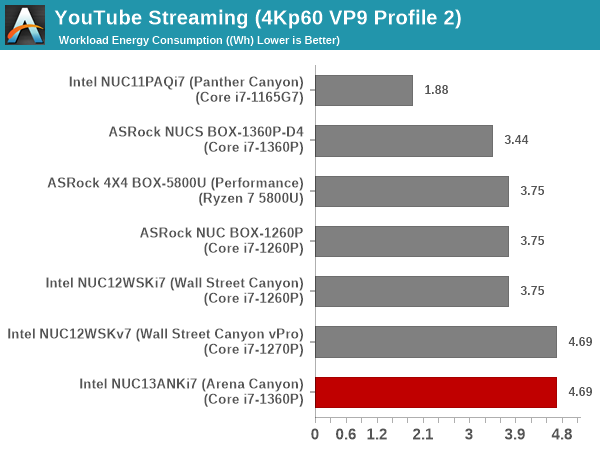
Energy consumption is a bit of a mixed bag, with the Arena Canyon NUC turning out to be the worst of the lot. It is possible that the iGPU drivers are to blame, but we do not see the issue in other playback workloads.
Hardware-Accelerated Encoding and Decoding
The transcoding benchmarks in the systems performance section presented results from evaluating the QuickSync encoder within Handbrake's framework. The capabilities of the decoder engine are brought out by DXVAChecker.
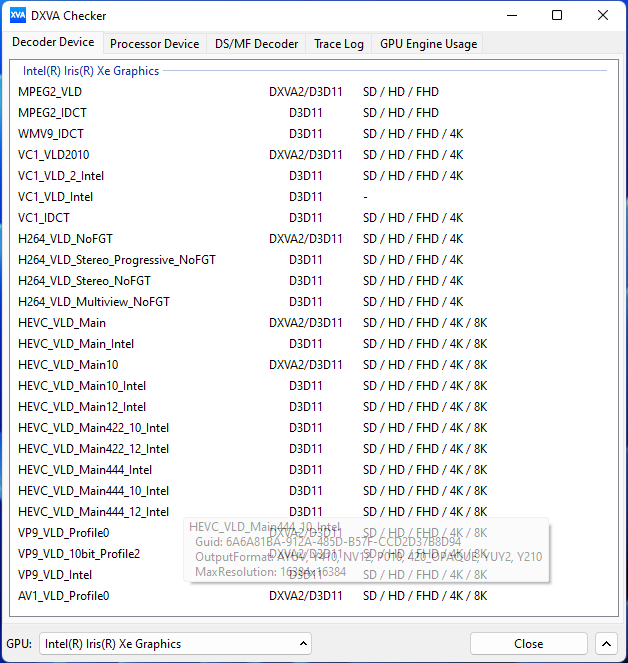
Video Decoding Hardware Acceleration in Intel NUC13ANKi7 (Arena Canyon)
The iGPU in Raptor Lake-P system supports hardware decode for a variety of codecs including AVC, JPEG, HEVC (8b and 10b, 4:2:0 and 4:4:4), and VP9 (8b and 10b, 4:2:0 and 4:4:4). AV1 decode support is also present. This is currently the most comprehensive codec support seen in the PC space.
Local Media Playback
Evaluation of local media playback and video processing is done by playing back files encompassing a range of relevant codecs, containers, resolutions, and frame rates. A note of the efficiency is also made by tracking GPU usage and power consumption of the system at the wall. Users have their own preference for the playback software / decoder / renderer, and our aim is to have numbers representative of commonly encountered scenarios. Our Q4 2022 test suite update replaces MPC-HC (in LAV filters / madVR modes) with mpv. In addition to being cross-platform and open-source, the player allows easy control via the command-line to enable different shader-based post-processing algorithms. From a benchmarking perspective, the more attractive aspect is the real-time reporting of dropped frames in an easily parseable manner. The players / configurations considered in this subsection include:
- VLC 3.0.18
- Kodi 20.0b1
- mpv 0.35 (hwdec auto, vo=gpu-next)
- mpv 0.35 (hwdec auto, vo=gpu-next, profile=gpu-hq)
Fourteen test streams (each of 90s duration) were played back from the local disk with an interval of 30 seconds in-between. Various metrics including GPU usage, at-wall power consumption, and total energy consumption were recorded during the course of this playback.
All our playback tests were done with the desktop HDR setting turned on. It is possible for certain system configurations to automatically turn on/off the HDR capabilities prior to the playback of a HDR video, but, we didn't take advantage of that in our testing.
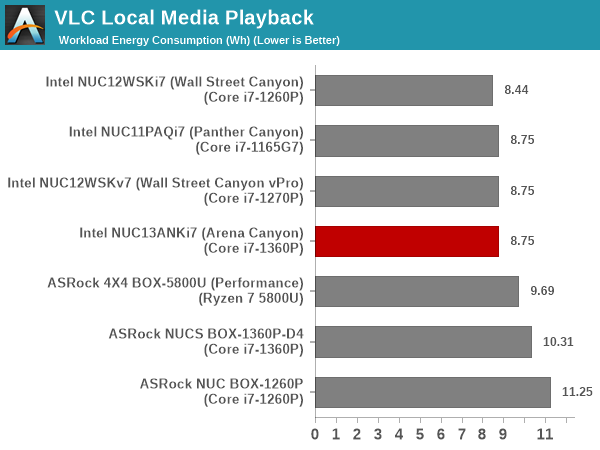
Playback was perfect for all codecs except AV1 (the CPU is not strong enough for software-only 8Kp60 decoding). Power consumption numbers are reasonable, and help the Arena Canyon NUC land up in the middle of the pack.

The scenario seen with VLC is replicated in Kodi also. The middle-of-the-pack entry seen in the VLC case makes an appearance here also, with the software decoding attempt for AV1 being one of the main causes for the spike in the energy numbers.
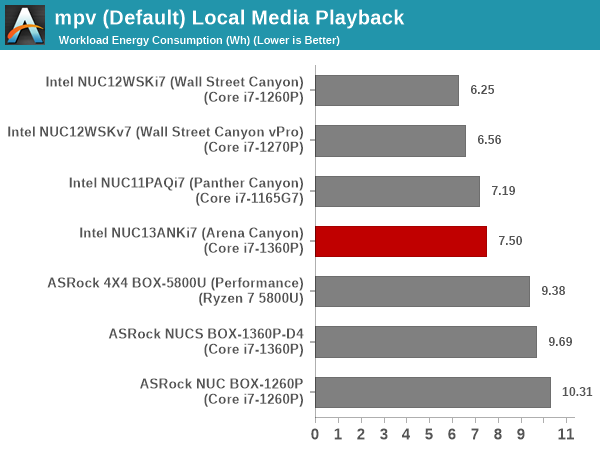
mpv playback with the gpu-next video output driver is the most energy efficient of the lot. We also have hardware accelerated decode for AV1. However, the playback for that clip still has issues, with approximately 60% of the frames getting dropped in the video output (the decoder itself doesn't drop any frames).
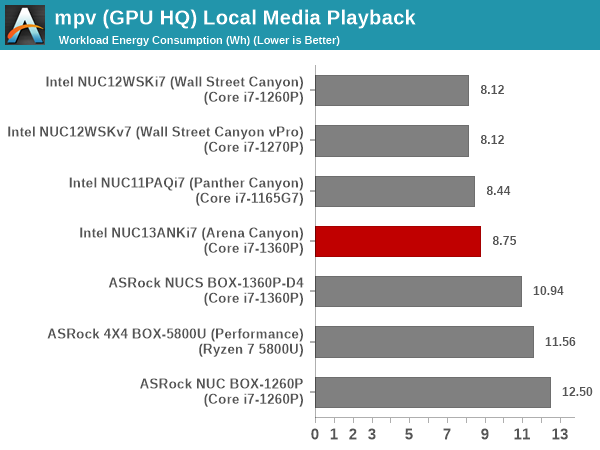
Activating the GPU shaders for video post processing does result in increased energy consumption, but there are no dropped frames. The 8Kp60 AV1 decode video output issue remains the same irrespective of the profile used.


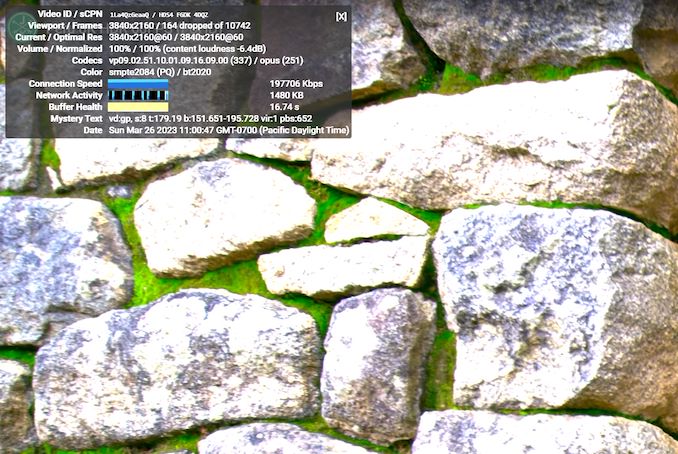

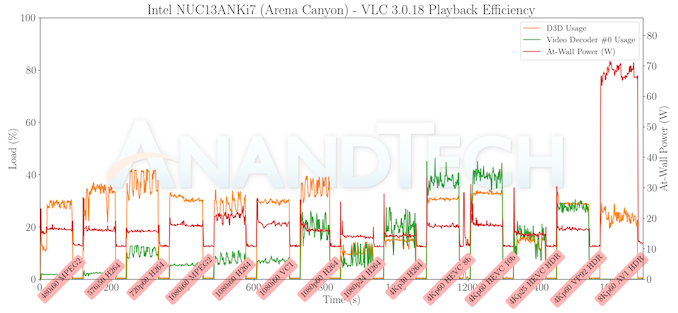

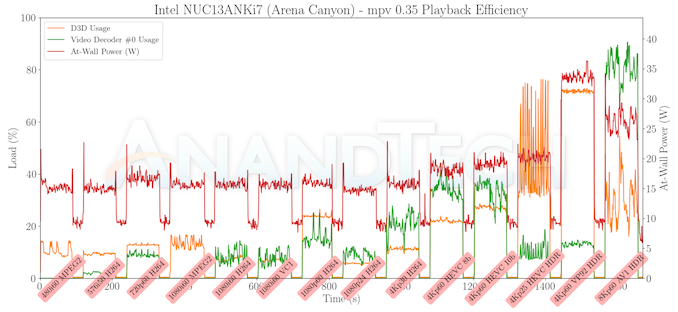
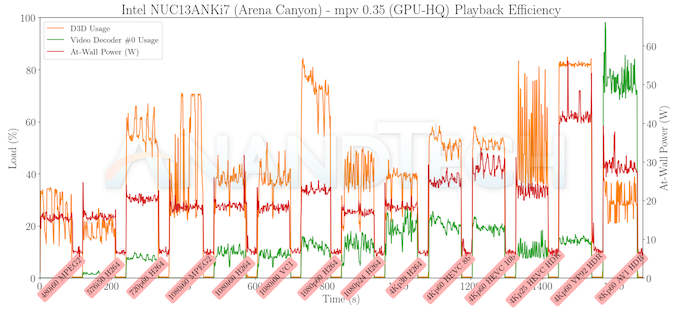








46 Comments
View All Comments
hmurchison - Monday, March 27, 2023 - link
NUC are useless. Plastic computers with huge external power supplies yet people are actually trying to defend this shit. There's a reason why PC sales are in the sh***ter. For decades PC fanboys vomited out how much PC they could buy/build for the price we bought our Mac. Now PC aren't even that affordable. I'd rather buy a M2 Mini as well. I got Thunderbolt, easy upgrade to 10G networking. The PC industry is beyond boring right now.meacupla - Monday, March 27, 2023 - link
I think it's funny you think PC sales are being eaten up by macs.They're not.
The largest market share is from smartphones, and it's primarily Android that has been eating Windows PC market share.
The breakdown of share is basically this
43.9% Android
27.7% Windows
17.1% iOS
6.2% OSX
5.1% Other and Unknown
MrCommunistGen - Monday, March 27, 2023 - link
I don't understand the animosity that exists in the Mac vs non-Mac camps. I have and have used both platforms -- Macs since around 1990 and Windows PCs since around 2002 and continue to use both in my professional career. Each has their place and use cases.Just because a product doesn't match your world-view, regardless of which platform you prefer, doesn't make the other worthless or useless.
Regardless of which platform ultimately takes the performance crown, M2, M2 Pro, etc or Raptor Lake, there's no denying that the various iterations of Apple Silicon have amazing perf/W which is especially beneficial in laptop form-factors. It's also really nice for quiet, high performance computing in small form factors, whether that's a SFF desktop or a laptop.
That said, there are also advantages to the upgradeability of non-Apple devices. The ability to upgrade RAM or storage down the road, whether due to budget limitations at the original time or purchase, or whether you're taking advantage of lower prices in the future can help REDUCE eWaste by allowing an otherwise adequate machine to continue to be used rather than discarded.
It doesn't help Apple's case that in addition to being non-upgradeable they DO charge pretty high prices for upgrading RAM or storage on their machines. +$200 for upgrading from 8GB of RAM to 16GB, or from 256GB of SSD to 512GB is pretty steep (especially since Apple is paying bulk prices) when as an individual you can buy either a 64GB DDR4 3200 SO-DIMM kit or 2TB NVMe SSD for less than $150 at retail.
To directly address the claim that NUCs are useless:
These aren't designed for your average home user. That's not to say that an average home user can't or shouldn't buy a NUC. But really, one of the major intended audience is big corporate offices where the NUC can be VESA mounted to the back of a display and the power brick can be stashed away under a desk.
Also, MOST non-Atom/Pentium/Celeron NUCs (including the 13th generation models in this article) have Thunderbolt.
Circling back to what I hope my key takeaway is:
Can't we all just agree that we all like tech and that new technology is cool rather than just needing to bash on whoever has a different opinion than us?
Samus - Tuesday, March 28, 2023 - link
Ditto. I use both. In fact I have an iPhone, iPad, Intel i7 custom-built gaming PC, Ryzen 5600G HTPC for media, 8th Gen Dell Latitude work laptop and my old Macbook Air for when I need OSX for something like testing a clients software. I have a Pixel 3 without cellular connection to fly my drone (because frankly the iPad and iPhone suck for this) and use Android and Raspberry Pi's for projects of all kinds. I've considered getting an M2-based laptop as soon as they are financially viable to replace my aging iPad Pro as my kitchen table media toy.This is the definition of a competitive industry benefiting the consumer and pushing technology forward. EVERYTHING HAS ITS APPLICATION.
ingwe - Tuesday, March 28, 2023 - link
Spot on. I also don't understand the need to be a fanboy of these gigantic companies that care nothing for individuals.I'm perfectly happy to use whatever fits my application.
block2 - Tuesday, April 4, 2023 - link
Been building PCs since 1999 and do not recall upgrading any. Once they need more RAM the CPU is also too slow. I replaced HD with SSD many years ago before many people had SSD which was huge upgrade. Still using that PC (2.8Ghz AMD Phenom II)!!!Pixol22 - Tuesday, March 28, 2023 - link
I'm pretty sure this is bait, but I'll bite. NUCs are not useless, because NUCs are real computers. Mac minis are gimmick computers more alike to an iPhone than a desktop computer. If you buy a NUC, you can use it to run or host anything you'd like, between multiple operating systems. Yes it matters to me if hardware is supported by Linux or not. You can also upgrade components using industry standard technologies like M.2, SODIMM, SATA. Apple exists in this strange bubble outside the industry and at every single opportunity they will screw over their customers with crazy pricing, hostile repair practices, and expertly designed price brackets designed to cause distress in customers so they just spend $200 more...$200 more...$100 more. Also, I am not sure how you came to the conclusion that PCs are more expensive, as AMD and Intel have caught up to Apple Silicon, and PC manufacturers offer more competitive upgradeable components for a lower cost.Pixol22 - Tuesday, March 28, 2023 - link
As a M1 Mac mini owner, been there, done that. There is a lot to like about that computer, but a lot more limitations that make it so infuriating. First, Apple starts those machines at $600 but Apple charges a whopping $200 for an extra 8 GB of ram, which is ridiculous. Then you have to pay $200 extra for 512gb of storage instead of 256gb of storage. Apple's flash isn't even particularly fast, and it is soldered. So all those people that would worry about SSD failure, I hope you are comfortable de-soldering flash. (If such a thing is possible.) Another annoyance is the base configuration with the M2 has a very limited display engine on the GPU, which means you only get two monitors, and the built in HDMI port is more problematic than its worth as it constantly limits resolution, refresh rate, HDR, and variable refresh rate. Perhaps worst of all, the Mac mini comes with macOS and there is no choice to change the operating system, even though there has been some progress on reverse engineering, it is not useful. Running a server or something on a Mac mini is simply painful. I suggest that most people avoid the Mac mini even though the marketing seems appealing.abufrejoval - Tuesday, March 28, 2023 - link
My oranges have 64GB of RAM not 8GB, and 2TB of NVMe not 250GB.And I use 10Gbit networking via TB, because they run containers and VMs as µ-servers, not sure if Apple allows NICs they don't sell.
You can't even get 64GB of RAM from a Mini, while it's €120 including taxes on Intel or AMD.
You fancy 8TB of NVMe next year, no issue swapping the stick, some NUCalikes offer a 2nd slot.
I seriously wouldn't mind an Apple SoC in my Linux systems, but not with the ballast of MacOS or the prices they charge for meaningful configurations.
Fenturi - Tuesday, March 28, 2023 - link
Until the SSD runs out. Apple needs to not make systems that can't swap the SSD and RAM, none upgradeability on the SSD is a deal breaker.